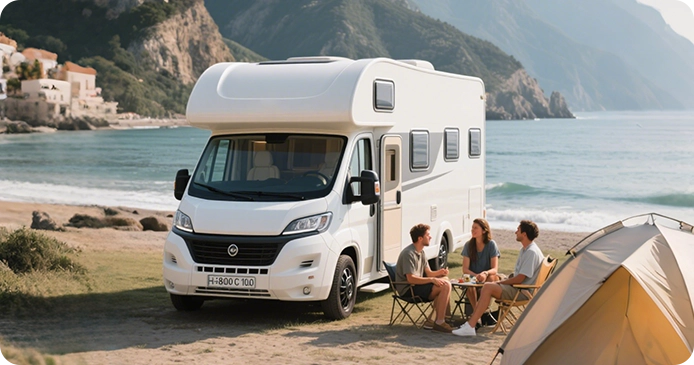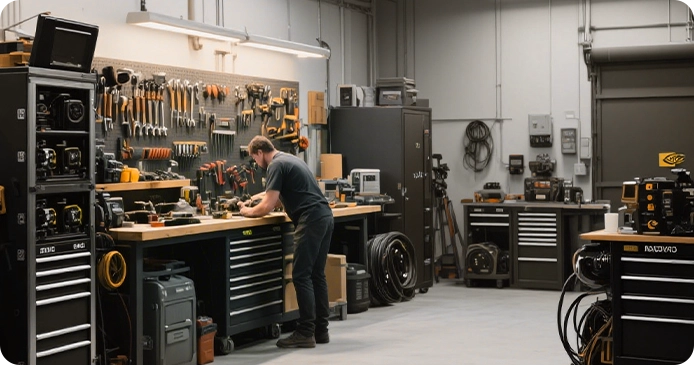Startseite
>
Erhalten Sie die neuesten Nachrichten aus der LiFePo4-Batteriebranche
>
Die 5 besten Lithium-Batterien für netzunabhängige Solaranlagen
Die 5 besten Lithium-Batterien für netzunabhängige Solaranlagen
von/ durch
Emma Larson
am Okt 30 2025
Reading time 10 minutes
Wenn Sie eine Solaranlage in einer abgelegenen Hütte, einem Wohnmobil, einem Boot oder einfach als Backup für netzgebundenen Solarstrom betreiben, ist die Wahl der Batterie einer der wichtigsten Faktoren für Ihre Energieversorgung. Eine gute Lithium-Solarbatterie speichert nicht nur Strom, sondern ermöglicht Ihnen auch längere Betriebszeiten Ihrer Geräte, reduziert Ihre Abhängigkeit vom Stromnetz oder Generatoren und bietet Ihnen ein wartungsärmeres und zuverlässigeres System.
In diesem Leitfaden erfahren Sie alles Wichtige über die verschiedenen Batterietypen, warum Lithium-Batterien (insbesondere LiFePO4) sich besonders für netzunabhängige Systeme eignen, wie Sie die passende Batterie für Ihre Bedürfnisse auswählen und welche fünf Lithium-Batterien sich optimal für Solaranlagen eignen. Egal, ob Sie einen kompletten Heimspeicher aufbauen oder eine kleine netzunabhängige Anlage installieren möchten – dieser Artikel hilft Ihnen, eine Solarenergielösung mit langer Lebensdauer zu finden.

Was ist eine Lithium-Solarbatterie und wie funktioniert sie?
Bei einer netzunabhängigen Solaranlage ist der Batteriespeicher das Herzstück des Energiesystems. Hier ist eine vereinfachte Schritt-für-Schritt-Anleitung, wie die einzelnen Komponenten miteinander verbunden werden:
- Solarpaneele gewinnen Energie aus der Sonne (Ihrer Energiequelle).
- Ein Solarladeregler oder MPPT regelt diese Energie in eine geeignete Form.
- Die Batterie speichert die Energie, bis Sie sie benötigen.
- Wenn Ihre Verbraucher (Lampen, Haushaltsgeräte, Wechselrichter) Strom verbrauchen, entlädt sich die Batterie über einen Wechselrichter (bei Wechselstromverbrauchern) oder direkt (bei Gleichstromverbrauchern).
Wenn wir von einer „Lithium-Solarbatterie“ sprechen, meinen wir konkret eine Batterie mit Lithiumchemie – häufig LiFePO4 („Lithium-Eisenphosphat“) – und nicht ältere Batterietypen wie Bleiakkumulatoren. Wichtigste Funktionsmerkmale:
- Ein Batteriemanagementsystem (BMS) überwacht und schützt den Akku vor Überladung, Tiefentladung, Überstrom und extremen Temperaturen.
- Die Zellchemie bestimmt, wie tief man sicher entladen kann (DoD = depth of discharge), wie viele Zyklen der Akku durchhält und wie effizient der Lade-/Entladevorgang ist.
- Die Ladezeiten sind wichtig: Wie schnell kann der Akku sicher und ohne Beschädigung geladen werden und wie schnell lässt sich die nutzbare Kapazität nach einem sonnigen Tag wiederherstellen?
Mit LiFePO4 erzielen wir typischerweise eine hohe Energiedichte, eine höhere nutzbare Entladetiefe, eine längere Lebensdauer und eine bessere Toleranz gegenüber wiederholten Tiefentladezyklen.
Gängige Batterietypen in Solaranlagen und ihr Vergleich
Um Ihnen einen intuitiveren Vergleich zu ermöglichen, haben wir eine Vergleichstabelle erstellt, die hauptsächlich gängige Batterietypen vergleicht, die in netzunabhängigen oder solarbetriebenen Notstromsystemen vorkommen.
| Akku-Typ | Chemie / Beispiel | Typisches Verteidigungsministerium | Ungefähre Zykluslebensdauer | Wartungsbedarf | Gewicht / Größe & Anwendungsfall |
|---|---|---|---|---|---|
| Bleiakku | Überflutet oder AGM | ~50% | ~300–800 Zyklen | Regelmäßige Wartung (Wasser nachfüllen, Druckausgleich) | Schwerer, sperriger, geringere Energiedichte |
| Lithium-Eisenphosphat (LiFePO₄) | Lithium-Solarbatterie | ~80–100 % | 3000–6000+ Zyklen | Wartungsfrei | Leichter, kompakter, geeignet für netzunabhängige Anwendungen |
Diese Tabelle zeigt, warum LiFePO4-Batterien häufig die erste Wahl für netzunabhängige Solaranlagen sind. Sie bieten eine höhere nutzbare Kapazität, eine längere Lebensdauer und einen geringeren Wartungsaufwand. Bleiakkumulatoren hingegen sind zwar in der Anschaffung günstiger, erfordern aber regelmäßige Wartung, haben eine kürzere Lebensdauer und müssen häufiger ausgetauscht werden.
Warum sollte man sich für eine Lithiumbatterie für netzunabhängige Solaranlagen entscheiden?
Wenn Ihr Ziel ein netzunabhängiges Solarsystem mit Langlebigkeit, geringem Aufwand und kostengünstiger Leistung ist, sollte eine Lithium-Solarbatterie aufgrund ihrer folgenden Vorteile definitiv Ihre erste Wahl sein:
- Lange Lebensdauer : Viele LiFePO4-Akkus erreichen Tausende von Ladezyklen (2000-6000+), was bedeutet, dass sie tiefentladen und häufig geladen werden können und trotzdem viele Jahre zuverlässig funktionieren, bevor sie ausgetauscht werden müssen.
- Hohe nutzbare Kapazität : Da Sie oft ~80-100% der Nennkapazität sicher entladen können, ist die effektiv nutzbare Energie höher, was eine längere Nutzungsdauer Ihrer Anlage bedeutet.
- Geringer Wartungsaufwand : Lithium-Akkus benötigen im Vergleich zu Bleiakkumulatoren (die Wasser nachfüllen, Druckausgleich durchführen und auf Sulfatierung prüfen müssen) in der Regel nur sehr wenig Wartung.
- Bessere Effizienz & schnellere Erholung : Höhere Gesamteffizienz bedeutet weniger Energieverlust beim Speichern, schnelleres Laden bedeutet, dass die Leistung Ihrer Paneele effektiv genutzt wird.
- Besserer Wert am Ende der Lebensdauer : Da sie länger halten, sind die Kosten pro nutzbarer kWh über die gesamte Lebensdauer des Systems oft niedriger (kosteneffizienter unter Berücksichtigung von Austauschzyklen und Ausfallzeiten).
- Systemkompatibilität und Flexibilität : Lithium-Batteriebänke können oft höhere Ströme verarbeiten, sich in fortschrittliche Systeme integrieren, eine modulare Erweiterung ermöglichen und kompaktere Installationen realisieren – was beim Aufbau eines netzunabhängigen Solarenergiesystems von Vorteil ist.
Wie Sie die richtige Lithiumbatterie für Ihr netzunabhängiges Solarsystem auswählen
Nachdem Sie entschieden haben, welcher Solaranlagentyp am besten zu Ihren Anforderungen passt, müssen Sie auch die richtigen Batterien auswählen. Im Folgenden finden Sie einige Kaufkriterien, die Ihnen helfen, Ihr System optimal auf Ihren Strombedarf, Ihr Budget und Ihre Systemarchitektur abzustimmen:
- Schätzen Sie Ihren Energieverbrauch : Wie viele kWh (oder Wh) verbrauchen Sie pro Tag (Beleuchtung, Haushaltsgeräte, Wechselrichterverluste)?
- Wählen Sie die Systemspannung : Viele netzunabhängige Systeme nutzen 12 V (kleine Lasten/Wohnmobil), 24 V (mittelgroße Systeme) oder 48 V (größere Haussysteme). Niedrigere Spannungen können zu höheren Strömen und einem größeren Kabelquerschnitt führen, höhere Spannungen sind für größere Lasten oft effizienter.
- Berechnung der benötigten Batteriekapazität : Wenn Sie 5 kWh/Tag verbrauchen und eine Autonomie von 2 Tagen wünschen, benötigt die Batteriebank bei 80 % Entladetiefe (DoD) etwa (5 kWh × 2) / 0,8 = ~12,5 kWh.
- Prüfen Sie Ladezeiten und Panelgröße : Bei begrenzter Sonneneinstrahlung ist die Fähigkeit zum schnellen Aufladen entscheidend – die Batterie muss höhere Ladeströme aufnehmen können und Ihr Solarpanelsystem muss diese liefern können.
- Berücksichtigen Sie Erweiterungsmöglichkeiten und Modularität : Möchten Sie die Kapazität später erhöhen? Stellen Sie sicher, dass die Batteriebank skalierbar ist (Parallel-/Serienschaltung möglich) und mit Ihrem Wechselrichter/Überwachungssystem kompatibel ist.
- Prüfen Sie Support und Garantie : Achten Sie auf die Qualität des Batterieherstellers, das Servicenetz und Nutzerbewertungen. Ist Versand und Logistik zuverlässig?
- Sicherheit und Installation : Achten Sie auf Belüftung, Temperaturmanagement (insbesondere an netzfernen Standorten), korrekte Verkabelung, Absicherung, BMS-Funktionen und Wartungszugang.
Kurzvergleichstabelle: Spannung und Kapazität
| Akku-Typ | Chemie / Beispiel | Typisches Verteidigungsministerium | Ungefähre Zykluslebensdauer | Wartungsbedarf | Gewicht / Größe & Anwendungsfall |
|---|---|---|---|---|---|
| Bleiakku | Überflutet oder AGM | ~50% | ~300–800 Zyklen | Regelmäßige Wartung (Wasser nachfüllen, Druckausgleich) | Schwerer, sperriger, geringere Energiedichte |
| Lithium-Eisenphosphat (LiFePO₄) | Lithium-Solarbatterie | ~80–100 % | 3000–6000+ Zyklen | Wartungsfrei | Leichter, kompakter, geeignet für netzunabhängige Anwendungen |
Indem Sie diese Punkte vor der Auswahl eines Batteriemodells klären, können Sie sicherstellen, dass die gewählte Batterie den Anforderungen Ihres Systems entspricht und mit Ihrer Solaranlage kompatibel ist. So vermeiden Sie unnötige Verschwendung aufgrund von Kapazitätsunterschieden oder unzureichender Kapazität, die später zu Bedauern führen könnte.
Die 5 besten Lithium-Batterien für netzunabhängige Solaranlagen
Hier sind fünf herausragende Modelle der Vatter-Batterieserie, die sich ideal für netzunabhängige Solaranlagen eignen. Die endgültige Entscheidung können Sie anhand Ihrer individuellen Nutzungsumgebung und Ihres Energiebedarfs treffen.
Wasser 12V 460Ah Selbstheizend
Wählen Sie diese Batterie, wenn Sie eine große 12-V-Lithium-Solarbatterie benötigen, die sich problemlos in Wohnmobile, Boote oder kleine Hütten einbauen lässt, ohne dass das gesamte Solarsystem umgebaut werden muss. Die selbstheizende Schicht sorgt auch bei Kälte für zuverlässiges Laden, sodass Sie bei sinkenden Temperaturen keine Erntetage verlieren.
Vorteile:
- Lange Lebensdauer und hohe nutzbare Kapazität: Die LiFePO4-Chemie unterstützt tiefe Ladezyklen mit hoher Entladetiefe und bietet so eine längere Laufzeit im realen Einsatz als vergleichbare Blei-Säure-Batteriebänke.
- Kältebeständigkeit: Die Selbsterhitzung schützt den Ladevorgang bei niedrigen Temperaturen und verkürzt die Ladezeiten im Winter.
- Wartungsfreies Design: Kein Bewässern oder Ausgleichen erforderlich, das BMS schützt vor Über-/Unterspannung, Überstrom und Temperaturfehlern.
- Langfristig kostengünstig: Weniger Batteriewechsel im Vergleich zu Blei-Säure-Batterien, bessere Gesamteffizienz und höhere Energiedichte.
Ideal für:
Wohnmobile, Lieferwagen, Tiny Houses, Boote, Jagdhütten, tragbare Solaranlagen, die noch auf einer 12-V-Architektur basieren, aber eine hohe Leistungsfähigkeit über lange Zeit und eine lange Lebensdauer benötigen.
Wasser 24V 200Ah Selbstheizend
Ein idealer Kompromiss für Anwender, die von 12 V aufrüsten. Der Wechsel zu 24 V halbiert den Strom bei gleicher Leistung, wodurch Leitungsverluste reduziert und die Gesamtsystemeffizienz verbessert wird, ohne direkt auf 48 V umzusteigen.
Vorteile:
- Höhere Spannungseffizienz: Geringerer Strom bedeutet dünnere Kabel und weniger Wärme, ideal für mittelgroße Solarenergiesysteme.
- Selbstheizung für kalte Regionen: Hält die Batterie auch im Winter einsatzbereit, damit Ihre Solaranlage nicht ausfällt, wenn Sie sie brauchen.
- Skalierbare Batteriebank: Unterstützung für parallele Erweiterung zur Kapazitätserhöhung bei sich ändernden Energiequellen und Lasten.
- Stabile LiFePO4-Chemie: Lange Lebensdauer, hohes Sicherheitsprofil und wartungsfreier Betrieb.
Am besten geeignet für :
Werkstätten, netzunabhängige Gästehäuser, mittelgroße Hütten, mobile Büros oder beliebige 24V-Solarbatteriebanken, die auf bessere Effizienz und zuverlässige Leistung im Winter abzielen.
Wasser 51,2 V 100 Ah Rack-Montage
Wählen Sie diese Variante, wenn Sie einen ordentlichen, professionell aussehenden Batteriespeicher in einem Standardgehäuse bauen möchten. Die 51,2-V-Architektur ist die erste Wahl für netzunabhängige Solaranlagen im Hausmaßstab.
Vorteile:
- 2V-Architektur: Niedrigerer Strom bei höherer Spannung verbessert die Leistung des Wechselrichters und reduziert die Leitungsverluste.
- Rackmontage-Bauform: Saubere Installation, einfache Skalierbarkeit und unkomplizierte Wartungsfreundlichkeit, ideal für modulare Solarenergiesysteme.
- Hohe Energiedichte und Effizienz: Mehr nutzbar auf kleinerem Raum bei hoher Gesamteffizienz.
- BMS-Schutzfunktionen & Kommunikation: Typische Unterstützung für Systemüberwachung/-integration, um den Batterietyp sicher und wartungsfrei zu halten.
Am besten geeignet für :
Heimbatterieräume, Serverschränke, kleine Gewerbebetriebe oder alle, die auf 48V LiFePO4-Batterien mit schrankbasierter Erweiterung umsteigen.
Wasser 51,2 V 200 Ah Wandmontage
Wenn Sie pro Modul etwa 10+ kWh benötigen, aber keine Stellfläche opfern möchten, ist die Wandmontage eine elegante, kompakte und projektfreundliche Lösung.
Vorteile:
- Platzsparende Wandmontage: Spart Bodenfläche, hält die Verkabelung kurz und ordentlich und sieht bei Installationen in Wohnräumen sauber aus.
- Hohe Kapazität pro Modul: Weniger Module erforderlich, um die Ziel-kWh zu erreichen, einfachere Stückliste und schnellere Inbetriebnahme.
- Hohe Energiedichte bei langer Lebensdauer: LiFePO4-Sicherheit plus Tiefentladefestigkeit für den täglichen Einsatz.
- Skalierbar und wartungsfrei: Bauen Sie eine größere Batteriebank, ohne die regelmäßigen Wartungsprobleme herkömmlicher Batterietechnologien in Kauf nehmen zu müssen.
Am besten geeignet für :
Autarke Systeme für ganze Häuser, hybride Solarenergiesysteme mit beträchtlichem Tagesbedarf, kleinere Gewerbebetriebe, die zuverlässige Langzeitspeicher mit ansprechender Wandmontage-Ästhetik suchen.
Wasser 51,2V All-in-One-System
Dies ist Ihre Schnelllösung – eine integrierte Einheit, die typischerweise Lithium-Solarbatterie, Wechselrichter und Solarladeregler (MPPT) vereint. Sie vereinfacht die Designentscheidungen und beschleunigt die Installation.
Vorteile:
- Komplettintegration: Weniger Geräte müssen spezifiziert, gekauft, montiert und verkabelt werden, die Inbetriebnahme ist unkomplizierter und der Support einfacher.
- Optimierte Kompatibilität: Die Koordination von Wechselrichter, BMS und MPPT reduziert Einrichtungsfehler und kann die Gesamtstabilität des Systems verbessern.
- Modulares Wachstumsmodell: Fügen Sie bei Bedarf weitere Einheiten parallel hinzu, um die Kapazität Ihrer Batteriebank zu erweitern.
- Benutzerfreundliche Überwachung: Eine zentrale Schnittstelle hilft dabei, Ladezeiten, Ladezustand und Systemzustand zu verfolgen.
Am besten geeignet für :
Hausbesitzer und Projektteams, die eine schlüsselfertige Lösung für netzunabhängige Häuser, abgelegene Standorte, mobile Geschäfte oder primär auf Backup-Solarenergie basierende Systeme mit minimalem Aufwand wünschen.
Warum Sie sich für Wasserbatterien für Ihr netzunabhängiges Solarenergiesystem entscheiden sollten
Wenn Sie eine netzunabhängige Solaranlage aufbauen oder modernisieren, sollten Sie die Batterieprodukte von Vatter als Kernstück Ihres Energiesystems in Betracht ziehen. Hier sind einige Gründe, warum die Batterielösungen von Vatter eine Überlegung wert sind:
- Schwerpunkt LiFePO4-Batterien : Vatter setzt auf Lithium-Eisenphosphat-Batterien, die sich perfekt für die Bedürfnisse netzunabhängiger Systeme eignen – lange Lebensdauer, hohe Sicherheit und große nutzbare Kapazität.
- Benutzerfreundliche Funktionen : Viele Modelle sind mit Bluetooth-Überwachung, Selbsterwärmung bei niedrigen Temperaturen (besonders wichtig in kalten Klimazonen) und einem eingebauten Batteriemanagementsystem (BMS) für Sicherheitsmanagement und Wartung ausgestattet.
- Skalierbare Architektur : Vatter bietet Batterien in verschiedenen Spannungsspezifikationen an, darunter 12 V, 24 V und 48 V, und verwendet modulare Wand- oder Rackmontage-Installationen, sodass Sie Batteriepacks entsprechend den Systemanforderungen und zukünftigen Erweiterungsanforderungen entwerfen können.
- Preis-Leistungs-Verhältnis : Obwohl die Anschaffungskosten höher sein können als bei herkömmlichen Technologien (wie z. B. Blei-Säure-Batterien), führen die lange Lebensdauer, die hohe nutzbare Kapazität, die geringen Wartungskosten und die Skalierbarkeit zu niedrigeren Gesamtenergiekosten über die gesamte Lebensdauer des Systems.
Installations- und Sicherheitstipps für netzunabhängige Solarbatterien
Die Installation eines Lithium-Batteriespeichers für eine netzunabhängige Solaranlage besteht nicht nur aus dem einfachen Zusammenstecken der Komponenten. Hier sind einige praktische Tipps, um Ihr System sicher, effizient und langlebig zu gestalten:
- Kabeldimensionierung und -schutz : Höhere Spannungen (24 V, 48 V) reduzieren Stromstärke und Kabelverluste. Verwenden Sie den korrekten Kabelquerschnitt und installieren Sie geeignete Sicherungen/Leitungsschutzschalter/Trennschalter zwischen Batteriebank und Wechselrichter/Ladegerät.
- Belüftung und Wärmemanagement : Obwohl LiFePO4 stabiler ist als einige andere chemische Verbindungen, ist ein Temperaturmanagement dennoch erforderlich. Wand- oder Rackmontagen sollten eine ausreichende Luftzirkulation gewährleisten, direkte Sonneneinstrahlung vermeiden und bei hohen Lade-/Entladeströmen für Kühlung sorgen.
- Temperatureinflüsse (insbesondere in kalten Klimazonen) : Funktionen wie Selbsterhitzungsschutz oder Abschaltautomatik bei niedrigen Temperaturen sind von Vorteil (und einige Vatter-Modelle verfügen darüber). Die Leistung des Akkus nimmt bei Kälte ab – vermeiden Sie Tiefentladungen bei Minusgraden, es sei denn, Ihr Akku ist dafür ausgelegt.
- Passende Systemkomponenten : Stellen Sie sicher, dass Ihr MPPT-Regler/Ladegerät mit Lithium-Ladeprofilen kompatibel ist (Spannungsabschaltungen und BMS-Schwellenwerte prüfen). Bei einer späteren Erweiterung des Systems achten Sie darauf, dass die neuen Batteriemodule hinsichtlich Spannung, Chemie, Kapazität und BMS-Kommunikation übereinstimmen, um einen sicheren Parallel-/Serienbetrieb zu gewährleisten.
- Vermeiden Sie das Mischen von Batterietypen oder -altern : Das Mischen verschiedener Marken, Kapazitäten oder chemischer Zusammensetzungen kann zu Ungleichgewichten, verminderter Leistung und verkürzter Lebensdauer führen.
- Regelmäßige Überwachung : Auch wartungsfreie Systeme profitieren von gelegentlichen Kontrollen, um sicherzustellen, dass BMS-Warnungen, Lade-/Entladeprotokolle und Kapazitätstrends überwacht werden.
Abschluss
Wenn Sie in ein netzunabhängiges oder mit hoher Notstromversorgung ausgestattetes Solarsystem investieren, ist der Batteriespeicher ein zentraler Bestandteil Ihrer Planung. Die Wahl eines Lithium-Solarspeichers (insbesondere LiFePO4) bietet Ihnen mehr nutzbare Energie, eine längere Lebensdauer, weniger Wartungsaufwand und eine Systemarchitektur, die auch bei steigendem Speicherbedarf und höheren Lasten skalierbar ist.
Die fünf besten Vatter-Solarbatterien decken ein breites Spektrum ab – von kleinen 12-V-Systemen für Wohnmobile bis hin zu modularen 51,2-V-Heimspeichern. Dank ihrer Funktionen, Kompatibilität und Markenspezialisierung eignen sie sich hervorragend für alle, die ein netzunabhängiges Solarsystem aufbauen oder erweitern möchten. Rüsten Sie jetzt auf und profitieren Sie vom Neukundenrabatt!
Teilen




















































